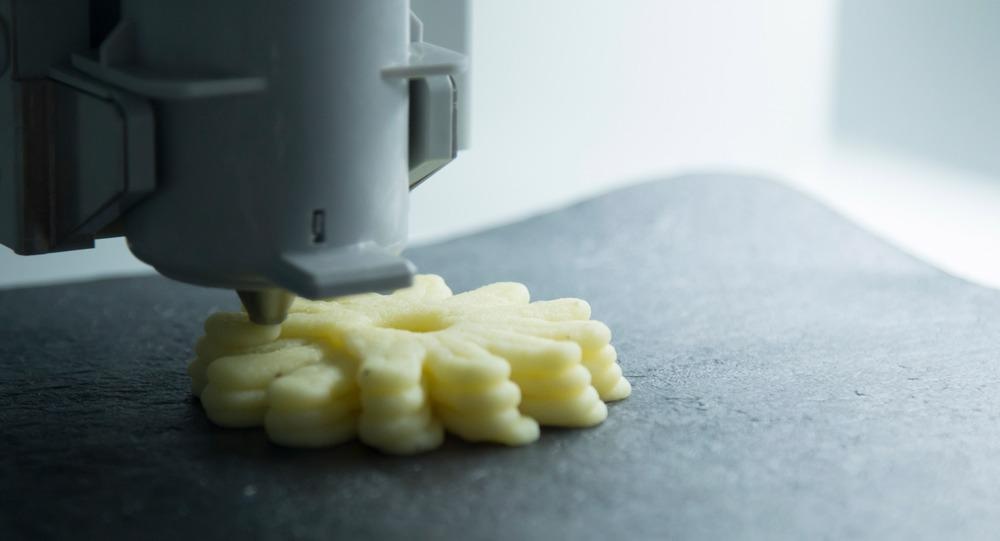3D printing has revolutionized the accessibility of complex part manufacture. The ability to deposit and cure resins layer by layer, often with micron levels of accuracy, has made it possible to create complex shapes and structures in a flexible and straightforward way.

Image Credit: foto_diego/Shutterstock.com
3D printing as an additive manufacturing technique is not just limited to resins as a substrate. Since 2007, additive manufacturing techniques have been applied to the creation of food.1 The development of so-called food printers made it possible to create complex shapes in a variety of foodstuffs, including chocolate and pastas, without the use of molds.
One of the big challenges has been finding ways to simultaneously print and cook foods with the same degree of spatial resolution. The lack of cooking capabilities has limited the types of foodstuffs that could be printed. However, much like many 3D printers make use of photo resins that can be cured quickly with a laser during the printing process, for 3D-printed food, a similar concept has now been applied using lasers to perform the cooking process.
Cooking Techniques
When an object absorbs light, the energy produced can be converted into thermal energy. As laser beams can be well-controlled in terms of spot size, power, and wavelength, meaning the thermal load they provide can also be precisely controlled, lasers have been used as a way of cooking food.2 However, one of the challenges is finding the optimal conditions for the laser irradiation to achieve sufficient depth penetration and cooking levels in several different foodstuffs.
A recent study has investigated the effect of different irradiation wavelengths on the cooking properties of chicken meat in combination with 3D printing.3 The team made use of blue (445 nm), near-infra-red (980 nm), and mid-infra-red (10.6 µm) lasers to see how the different wavelengths affect factors such as meat browning, levels of bacterial killed, and overall cooking times.
Laser Cooking
During cooking, it is essential that the food reaches a safe temperature. The team trialed several different irradiation patterns to determine what thermal energy needed to be supplied to achieve such temperatures in the meat. What they found was that multiple passes of a single spot in a pattern at high laser speeds resulted in quick initial temperature increases and slow subsequent ones. The overall energy supplied was still sufficient to achieve the required temperature increase. Reducing irradiation times could also have been achieved by increasing the laser power.
Certain patterns were also found to be more efficient at achieving the cooking of the entire sample. Multiple shorter laser passes led to greater amounts of ambient cooling and so would require longer cook times.
One of both the advantages and challenges of using lasers for cooking food is that, unlike microwaves that provide very uniform heating, the increase in thermal energy is highly localized. While this may be desirable in some foodstuffs and be a way of selectively cooking parts of the food substrate, for meat samples where the safe cooking temperature needs to be reached throughout the sample, the laser patterning needs to account for this.
The Right Wavelength of Light for Food Cooking
Different wavelengths of light often have different penetration depths as the upper layers of the sample may be more or less transparent to them.
The team found that blue laser irradiation gave the greatest penetration depth but also had the most localized heating effect. As infra-red radiation is absorbed particularly efficiently by water, this led to rapid browning and a very large heat-affected zone.
The mid-infra-red laser resulted in very little vertical penetration through the sample, though showed good results for surface level browning of the chicken. While this may be problematic for trying to cook thick layers of foodstuffs, one advantage of combining laser cooking with 3D printing is that the printing process is typically performed in thin layers. This means each layer can be put down and cooked, without any concern that the previous layers would become overexposed to the laser radiation.
Overall, lasers can be used to achieve several cooking types in meat – broiling, browning, and penetrative cooking. The penetration depths of the blue laser made it ideal for the latter whereas the infra-red lasers were more suited to the other types of cooking. As digital control of laser systems is relatively straightforward, it could be possible to use several different wavelengths in a 3D printing system to combine these properties to achieve the desired effects in the final product.
Another interesting aspect of laser cooking of meat is that the team found lasers could be used to irradiate samples in plastic packaging and still achieve safe cooking temperature. While overall cooking times were longer, this meant that food could be pre-prepared in an antimicrobial environment and only removed when safely cooked.
Overall, the team found that the cooking quality could be well-controlled through laser cooking processes, and while cooking bulk meats may prove challenging, combining high power laser systems with faster cook times and 3D printing may be the perfect way to create highly controlled and sterile foodstuffs.
References and Further Reading
- Pallottino, F., Hakola, L., Costa, C., Antonucci, F., Figorilli, S., Seisto, A., & Menesatti, P. (2016). Printing on Food or Food Printing: a Review. Food and Bioprocess Technology, 9(5), 725–733. https://doi.org/10.1007/s11947-016-1692-3
- Blutinger, J. D., Meijers, Y., Chen, P. Y., Zheng, C., Grinspun, E., & Lipson, H. (2018). Characterization of dough baked via blue laser. Journal of Food Engineering, 232, 56–64. https://doi.org/10.1016/j.jfoodeng.2018.03.022
- Blutinger, J. D., Tsai, A., Storvick, E., Seymour, G., Liu, E., Samarelli, N., Karthik, S., Meijers, Y., & Lipson, H. (2021). Precision cooking for printed foods via multiwavelength lasers. Npj Science of Food, 5(1), 1–9. https://doi.org/10.1038/s41538-021-00107-1
Disclaimer: The views expressed here are those of the author expressed in their private capacity and do not necessarily represent the views of AZoM.com Limited T/A AZoNetwork the owner and operator of this website. This disclaimer forms part of the Terms and conditions of use of this website.